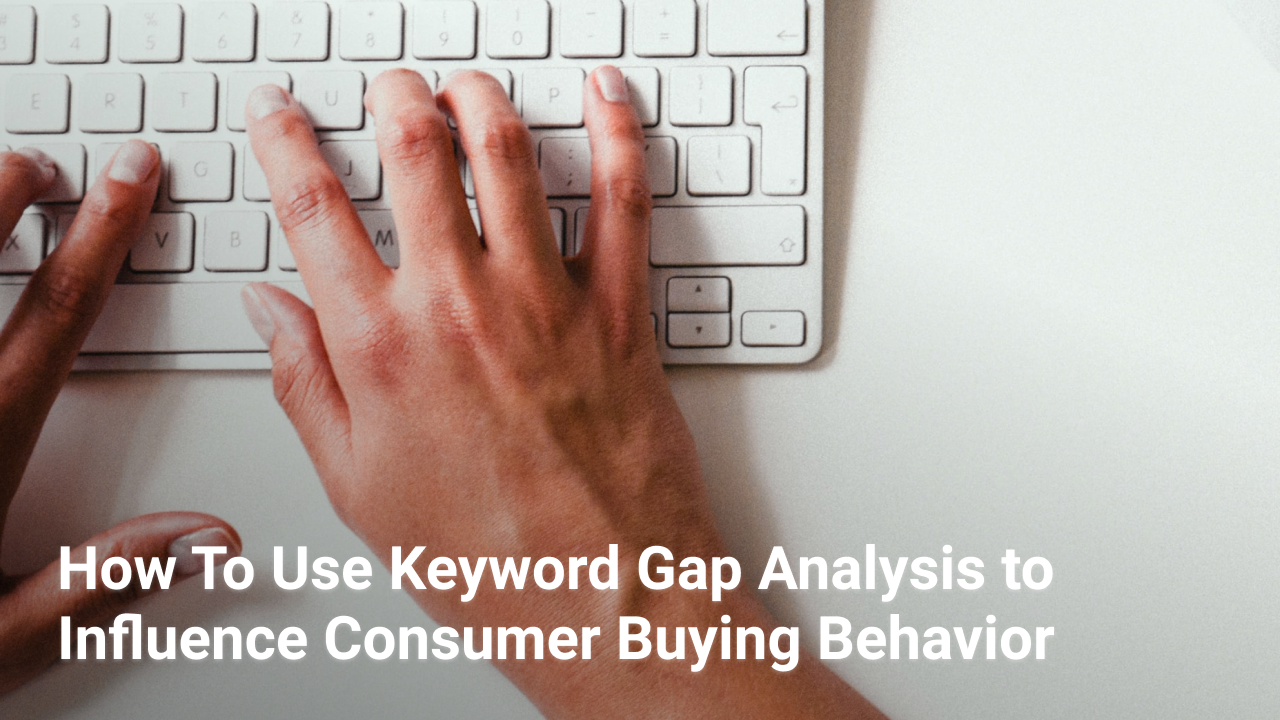[ad_1]

Businesses exist because of customers.
Regardless of what industry you are in or what products or services you sell, your customers are the most important part of your business. Because without customers, there is simply no business for your company to exist.
As a result, your marketing must factor in what influences consumer behavior.
Marketing is so much more than creating a catchy phrase or jingle. You need to figure out how to meet your customers’ needs, what their values are, and speak to them in ways that they would want to engage to build a successful marketing campaign.
But what exactly is consumer behavior and why is it important to marketers?
What is Consumer Behavior?
Consumer behavior definition in marketing is the study of how people make purchasing decisions and understanding the reasons that affect their purchase, such as social or psychological factors.
It is a study that uses data insights from surveys and reports to find the “why” behind each buying decision. Often, this means looking into different facets of consumer behavior and answering questions like:
- What are the consumer perceptions about a certain brand, product, or service?
- What motivates a consumer to select one product over another and why?
- What factors in a consumer’s everyday environment affect buying decisions and why?
Of course, there are many more. But using the answers to these questions can help businesses make better decisions and effective marketing strategies by aligning their techniques with their desired target audiences.
As we have seen time and time again, successful brands and companies align their marketing strategies to factors affecting consumer behavior as to the foundation.
They’re not generating products and marketing plans based on their ideas alone, but instead, look into how consumers behave and take that information to match up their product design and marketing strategy to what consumers want and need.
Every consumer has a different thought process and motivation for buying a product. Despite being customers of the same product, their difference in lifestyle or income can have influences on behavior and their approach to purchasing.
As marketers understand the varying factors, they can adopt customer differentiation to tailor their strategies according to different consumer groups. With this, businesses can expand the width of their services to be able to effectively serve a wider group of consumers.
Besides, customers have come to expect personalization from companies. According to a report by Instapage, 74% of customers feel frustrated when website content is not personalized or catered to them.
This makes learning consumer behavior more necessary than before, as companies need to understand how to appeal to these consumers.
An extra point is, studying consumer behavior can also be helpful to quickly identify consumer opportunities. By studying what customers are looking for or emerging trends, your company can be the first to identify gaps that are not met.
For example, a recent change in consumer behavior is driven by COVID-19 that warrants the increasing need for health supplements that boost immunity.
Nutritional companies that monitored the change in eating patterns of consumers would be able to quickly react to this trend and produce immunity and respiratory health-boosting supplements to fill in the void in the marketplace.
Now that you understand the importance of your consumer behavior in marketing, this next section will show you how to put it to use in a 4-step process.
How to Integrate Consumer Behavior with Marketing?
1. Understand Your Consumers
First and foremost, it’s critical to understand your consumers. And where better to understand the factors that influence buying behavior of your target audiences than directly from your customers themselves.
Encourage your customers to drop a review or sign up with review platforms like G2 or Trustpilot to help solicit feedback.
Then, take the time to read your reviews, get feedback from customer support and search up your own products or website online to see what people are saying about your brand.
You can even do a quick Google search to see what people are saying about you. Just simply search your ”brand name + reviews”.
When going through your reviews, make sure you read them neutrally and try understanding where your consumers are coming from.
Here, you should be able to identify important insights like what is your customer’s favorite feature, why do customers prefer you from other brands, and more.
Most importantly, take the opportunity to create a buyer persona. This should help you have a better idea of who you are speaking to when creating your marketing campaigns.
For example, BiQ’s buyer persona may be male, small business entrepreneurs in their 30s who are operating a digital marketing business.
Take a look at how Keyword Gap Analysis drives success in Digital Marketing.
2. Know your Competitors
As good as you are with your customers, you must know your competitors even better. And in digital marketing, you can have direct and indirect competitors.
To quickly explain, direct competitors are businesses that compete with you directly by selling similar products or services. Meanwhile, indirect competitors are businesses that might be selling a different product or service but are potential substitute options. For example, think McDonald’s and Subway.
No matter the competitor, you are competing for the same resources — target audience.
By learning about who your competitors are and what they are offering can help you to make your products, services, and marketing stand out. It will also let you communicate with your target audience and set your prices competitively to navigate challenges in your market.
So how do you do this? It’s easy. Simply paste your domain URL in competitive analysis sites like Alexa or SEMrush to identify similar competition.
Next, dig up information on your competitors. Find out who they are and similarly, go through their reviews, customer feedback on them, and look for gaps you can take advantage of.
Look at this review for example, while many praise SEMrush SEO features and solutions, it can still be hard to navigate and overwhelming for beginners.
Understanding this gap, we have created BiQ SEO Suite which places emphasis on ease of use and friendly interface that has brought us our customers today!
3. Use Keyword Gap Analysis to Minimize the Gap Between Yourself and Your Competitors
At last, you can’t talk about digital marketing without keywords.
Now that you have your customers and competitors down, it’s time to do a complete keyword analysis for your domain and your competitors.
This is known as keyword gap analysis and it offers a side-by-side comparison between your keyword profile and your competitors’.
You can use tools like BiQ Rank Intelligence and simply enter the domains to start your keyword audit and discovery. The report will show you all the ranking keywords for each site and you can analyze them according to their rankings and traffic to compare them.
When going through the list, you want to look for overlapping and common keywords missing from your site. To make this easy, group your keywords into two categories:
a. Keywords you rank for, but they don’t
This category consists of your keyword strengths and represents search terms that you might be ranking higher over your competitors.
Make sure you track these keywords using BiQ’s Rank Tracking to keep track of your site traffic. Your ranking should correspond to your site traffic and will be a good indicator of the increase or drop based on your ranking.
This will let you keep an eye on the competitors who are trying to steal your keywords while tracking algorithm changes and other anomalies.
More importantly, these keywords should also inform you which are the relevant keywords you should be targeting. As you are already ranking high for these keywords, Google sees you as the authority for the topic and you might want to get an extra boost when you optimize or create content for related keyword groups.
b. Keywords your competitors are ranking for, but you don’t
This list consists of your keyword opportunities. Your competitors most likely have done the SEO and identify the valuable keywords that your audiences are searching for.
So make sure to identify decent volume, valuable keywords missing from your list and add them to your keyword strategy. You can target them by analyzing Google’s search results and finding gaps that will allow you to create better content.
On the other hand, if there are keywords you have already created content for but have still yet to rank high, analyze your ranking competitors’ keywords and identify if there are any missing keywords you should be optimizing into your existing content to make it more relevant.
For both scenarios, we recommend using BiQ’s Content Intelligence that will make the writing and optimizing process much easier. It offers WordGraph analysis which will automatically compare your content to the Top 10 rankings and provide suggestions to improve.
At the same time, take the chance to understand the keyword strategy your competitors have and decipher their tactics to get high traffic.
Overall, you should get insights and identify the differences between each domain’s ranking keywords. Look into your data and see what kind of keywords are each domain ranking for?
For example, is your domain ranking better for long-tail or short-tail keywords? What about your competitors’? How many keywords does your competitor include in their content? and more.
The key is to identify patterns and find search terms that you may have missed.
Often, many marketers target high volume keywords but you also want to pay attention to low search, high intent keywords as well.
Just imagine if you are an ecommerce store selling trainers, there are obvious phrases like brands and models of shoes that all your competitors will be targeting, but what about the specific long-tail keywords?
For example, extra-small shoe sizes, specific styles of shoes like cricket cleats. These phrases may not have a high volume of traffic, but by nature, they have high intent and are more likely to convert compared to keywords like Nike shoes.
You want to make sure you discover these hidden keywords during your gap analysis.
4. Understand The Types of Consumer Behavior In Your Industry

Now before you begin creating content for these keywords, there are 4 types of consumer behaviors you should know to better build your marketing funnel:
- Routine Shopping – Regular purchases done by consumers, this behavior is associated with low product pricing and shows low involvement without the need for much research. An example would be grocery shopping at the supermarket or buying snacks.
- Limited Decision Making – Buying products occasionally. Consumers in this category are purchasing something that costs more but is not expensive and will require a moderate amount of time for research, often through recommendations as they make the purchase. For example, buying clothes or looking for a good Mexican food place.
- Extensive Decision Making – Products in this category are usually unfamiliar to customers, expensive, and not frequently bought. This may take a longer time for research and consumers will be looking at multiple factors such as checking product ratings, asking friends and professionals for more information, comparing options before making the final decision.
- Impulse Buying – Impulse buyers often show the tendency of a customer making purchasing decisions at the spur of the moment, without planning in advance. These purchase decisions are often triggered by emotions or feelings.
Knowing this, your digital marketing interactions should be founded based on these 4 types of buying behavior.
Let’s say you are targeting impulse buyers, your sales page copywriting then should focus on triggering your customer’s emotions and place emphasis on limited-time offers.
5. Use the Discovered Hidden Keywords
Finally, one last important lesson is that even if you have your keywords, you need to learn how to use your keywords with the right type of content to convert your audience into qualified leads.
While most SEOs often resort to written content, you should also use different content types like infographics, videos, and other forms of content that match the user’s search intent.
According to a report by Wyzowl, 96% of people prefer watching an explainer video to learn more about a product or service and 84% of people say they made the decision to purchase a product or service after watching a brand’s video.
Despite this, in 2021, we still only see 14% of businesses using videos in their marketing mix.
What’s most important here is to always meet the search intent of the target keyword and align it with what your consumers are looking for. And most importantly, use these hidden keywords in your marketing to invoke a specific consumer behavior you want to target.
Read how to drive more organic traffic to your site on our recent blog.
Key Takeaway: Use Keyword Gap Analysis to Target Buyer Keywords and Shape Consumer Behavior
As the business world evolves, so do consumer habits and tastes. What stays the same is that consumer behavior is still the most vital component to crafting a great marketing campaign.
Digital marketing is about basing decisions on actual data. Understanding your consumer behaviors can deliver insights that will help you make better digital marketing decisions that drive action.
By integrating competitive keyword analysis and consumer behavior, your business can get an unprecedented advantage over your competitors in terms of product visibility and conversion.
So what are you waiting for? Start implementing keyword gap analysis into your marketing strategy today with RankingGap!
You can learn more about our keyword gap analysis strategies in our main blog here.
Updated: 2 August 2021
[ad_2]
Source link

